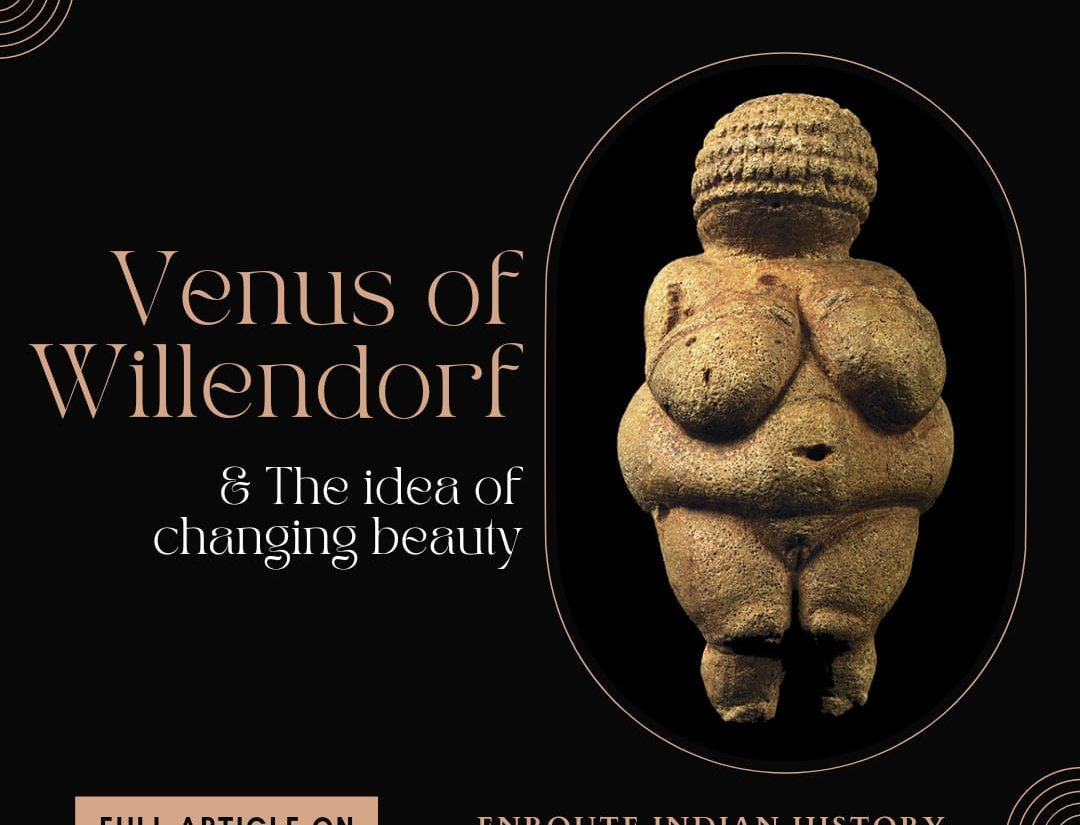The Venus Of Willendorf And The Changing Ideas Of Beauty
- iamanoushkajain
- March 8, 2022

Article by EIH Subject Matter Expert
Dr. Sonika Sandhu
‘Venus Figurines’ the oldest discovered representation of the female form. They are dated to the upper paleolithic of Europe which lasted from 50,000 to 10,000 years ago. These besides being female representations are also the earliest form of art created in the human image. These figurines have been discovered at multiple sites across Europe, the objects are small, diminutive and portable. They were made from a variety of materials like limestone, ivory, clay, bone etc. On a more cognitive analysis, the name ‘Venus Figurine” carries with it the implication that they were representations of feminine beauty and the ideal desirable female form at the time. According to Delport five possible interpretation could be drawn from these figurines:
- the statuettes might be realistic depictions of actual women,
- they might be ideal representations of female beauty,
- they could represent fertility symbols,
- they might have religious significance and be depictions of priestesses, and
- they could represent images of ancestors.
One thing is clear that prehistoric people were no doubt turning a recognition of health and fertility into more cultural icons in creating these figurines.
According to Plato beauty is not constant or stagnant, it is eternal, ever changing and universal, under this definition a women’s body played a crucial role in production of art, evoking philosophy, and propagation of ideals of beauty through the ages. Today most anthropologists agree that beauty is culturally driven and subjective, in other words, there is no absolute definition of ideals of beauty. Today norms of beauty are driven by various social processes and media. By looking at examples of from our past we can appreciate the fact modern notions of beauty are of recent nature and female body imaging is not static. The ideal female body and its conception has changed a lot since the Venus figurines were first conceived. Once a full bodied Venus was the archetype of beauty however today many cultures worship the unsustainable stick thin and toned form as an ideal.
In the past many cultures have tried to define the perfect human form, starting the ancient Greeks, where men had perfectly chiselled and athletic bodies, women were more desirable if they supported more fuller figures. A similarity can be drawn between the Venuses and the ideal women of ancient Greece with their large hips, full breast and a stomach undefined by their abdominal muscles. These traits can easily be found on the statues of Goddess Aphrodite; the Goddess of beauty and love and epitome of female beauty. These standards of fuller figures for women remained consistent till about Italian Renaissance, as can be seen in Botticelli’s iconic painting ‘The Birth of Venus’.
Similar comparisons and traits can be traced in the Indian subcontinent and its depiction of ideal forms of feminine beauty. According Dhavalikar, the first representations of women come from the Mauryan age. These images again show women with large breasts, wide hips and tapering legs. During the Sunga period from first century BCE, women were portrayed with elaborate hair styles, round breast, thinner waits and wide hips. The figures here lose their dynamism and are more stiff in their representation. This stiffness is lost half a century later wherein the women portrayed at Sanchi have been contorted to ‘S shape’. During the Kushan period (1stcentury CE-4thcentury CE) a standardization was seen in the way women were represented. Besides depicted in an ‘S’ form, eyes were placed at exactly two thirds of the way up on the face the bottom of the breast were placed one heads height below the chin, the whole figure stood seven heads high, the heads was more rounder in depiction. These were the idealized formats of beauty and were not natural. Another interesting representation is the portrayal of Goddess Parvati. She has been imagined to be the personification of absolute desirable beauty. She is represented with a slender body, rounded hips and a face compared to the moon, possibly to indicate that she glows with youthfulness and vitality. Her facial features have also been given much attention, with eyes like the lotus, lower lip like that of Bimba, nose as a parrot’s beak. A lot can be gathered by studying the sculptures of women from ancient India. From these studies a consistency is observed in the standards of beauty for women in India, where women with wider hips, thinner waits and globular full breasts and lotus eyes are regarded as beautiful. From Shringarashata of 5th century CE, the ideals of beauty can be summarized as
The coral beauty of her lower lip;
Those twin globes, her breasts,
Rising high in the pride of youth,
Her navels hollow, and diminutive waist;
Her hair by nature’s own hand curled
However of late in recent years these age old ideas of beauty in India are also changing. They are becoming more inclined with the western standards of beauty, possibly due to increased globalization and conforming to westernization processes. From above examples it can be seen that ideas of beauty have been biologically and culturally driven in the past, and even though representations of human body have changed in the past, beauty has never been about being slim. Today these ideas have been changed, women and people in general are far less concerned about fertility, thus biology or the need for procreation is no longer a driving attraction. Earlier fertility was sign of beauty, since this is no longer the case, culture & society dictates what is desirable today. Pop culture, social media exercise greater control over how women perceive their bodies and self-imaging. Most of these advocate thinner frames which goes against the natural tendency of women having higher fat deposits. Studies done in USA reveal that 85% women are not happy in their bodies and want to be thinner, on an average women in USA spend 12 hours in gyms every week, in 2017 alone 17.5 million cosmetic surgical treatments were undertaken by women. Around 20 million women in USA alone have eating disorders, such numbers are alarming when we think of the biological abilities of women and how detrimental it is in the long run.
Today the dictatorship of fashion stress on thinner athletic women, in the past it was the opposite. Plump women were symbols of beauty and were the Venuses of their times. From the Venus Figurines of Upper palaeolithic, to marble female statuettes featured strongly curved breasts and hips of Neolithic, fuller women were epitomes of prosperity. Curves were accentuated in the Cycladic culture and a violin shape was conceived as the female form of beauty. From the Mauryan standards to the curvaceous apsaras of the temples, Beauty has always been defined as being healthy and fertile. So Reveal in those curves on this women’s day.
References:
- Bracey, R. (2007). Ideals of Beauty in Indian Art.
- Dehejia, V. H. (2006). Parvati: Goddess of Love. Mapin Publishing.
- Dhavalikar, M. K. (1999). Historical Archaeology of India, New Delhi, Books & Books, pp. 1-274.
- Englis, B. G., Solomon, M. R., & Ashmore, R. D. (1994). Beauty Before the Eyes of Beholders: The Cultural Encoding of Beauty Types in Magazine Advertising and Music Television. Journal of Advertising, Vol 23 (2), pp. 49-64.
- Gelles, R. (2011). Fair and Lovely: Standards of Beauty, Globalization, and the Modern Indian Woman. Independent Study Project (ISP) Collection, pp. 1-38
- H. Delporte, L’Image de la Femme dans l’Art Prehistorique, Picard, Paris, France, 1979.
- M. D. Gvozdover, “The typology of female figurines of the Kostenki Paleolithic culture,” Soviet Anthropology and Archaeology, vol. 27, pp. 32–94, 1989.
- Madan, S., Basu, S., Ng, S., & Lim, E. (2018). Impact of Culture on the Pursuit of Beauty: Evidence from Five Countries. Journal of International Marketing, Vol 26 (4), pp. 1-52. Retrieved from: https://doi.org/10.1509/jim.17.0064 [01/05/2020].
- Runkle, S. (2004). Bollywood, Beauty, and the Corporate Construction of International Standards in Post Liberalization. South Asian Graduate Research Journal, Vol. 11.
- Varma, P.K. (2004). Love and Lust: An Anthology of Erotic Literature from Ancient and Medieval India. Harper collins, pp. 1-344.





